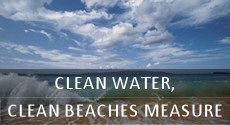Schools pooling up to oppose arbitrary storm-water tax
By Wayne Lusvardi
Why is only Los Angeles County being singled out to comply with a new state law to clean up so-called dirty storm water flowing to beaches? And how can this law be only imposed on Los Angeles County when its intent is to comply with the federal Clean Water Act? And if it is state law, why aren’t state funds provided to public schools to pay the tax?
These are questions that public school districts are starting to ask in reaction to a new state storm-water tax selectively imposed only in Los Angeles County. L.A. County’s Clean Water, Clean Beaches Measure is proposed to comply with State Assembly Bill 2554 passed in 2010.
Under the proposed program, each elementary school in the county would get hit with a tax of $8,000 per year. The Los Angeles Unified School District would have to pay $4.8 million annually. The Los Angeles Daily News reports that county school districts are opposed to the tax. Kerjon Lee of the L.A. County Department of Public Works, however, says it would be unfair to exempt public schools from the tax.
Public schools are one of the worst potential storm-water “polluters” because of the large land area they consume with impervious hard pavement and buildings. Storm water cannot easily percolate into the groundwater table through hard surfaces such as paved school playgrounds or public streets. Instead, rainwater flows into streets and storm water gutters and eventually flows downstream to river outlets and to public beaches.
Catchment basins
The tax would go toward building a network of storm-water catchment basins to reduce rainfall runoff from flowing into river flood channels to the beaches. One new storm-water basin would be built for about every 350 homes or 100 acres of land area. For the catch basins, the county would have to acquire homes by eminent domain, or use public parkland to acquire flood-basin easements. Surplus school facilities would also be prime sites on which to build catch basins. But if the water is “toxic,” then public parkland and surplus school sites could be tagged as “toxic dumps.”
What makes the county’s storm-water project so arbitrary is that state laws typically require all taxpayers in the state to share in the tax burden. Singling out only Los Angeles County for a storm-water tax appears inequitable. Why don’t Ventura County, Santa Barbara County, Monterey County and San Francisco County have to comply with storm-water rules if they are mandated under the federal Clean Water Act? Are beaches in those counties any less impacted by urban rainwater runoff? Why are other coastal counties in California exempt from compliance with the Clean Water Act?
The project also is a jobs program in a county hard hit by unemployment. Under provisions of the state law, about 50 percent of the taxes collected would go to providing jobs to “watershed groups” composed of lower-income residents and “water oversight boards” stacked with water experts.
There are too many unanswered questions about the county’s Clean Water, Clean Beaches program. And public school districts are in the lead in beginning to ask them. But the official answers don’t seem to adequately address: Why only Los Angeles County?
Related Articles
2014 promises water fight over Delta tunnels
Gov. Jerry Brown’s proposed twin tunnels under the California Delta will continue to be a major policy issue throughout 2014
Eminent domain mass delusion hits San Berdoo
July 16, 2012 by Wayne Lusvardi A few hundred years ago there was the famous Dutch Tulip Mania of 1637.
Wired is "tired"on Cali mass transit
Wired magazine runs a “wired/tired” feature, in which they judge new technologies as being “wired” — up-to-date, hip, cool, etc.




